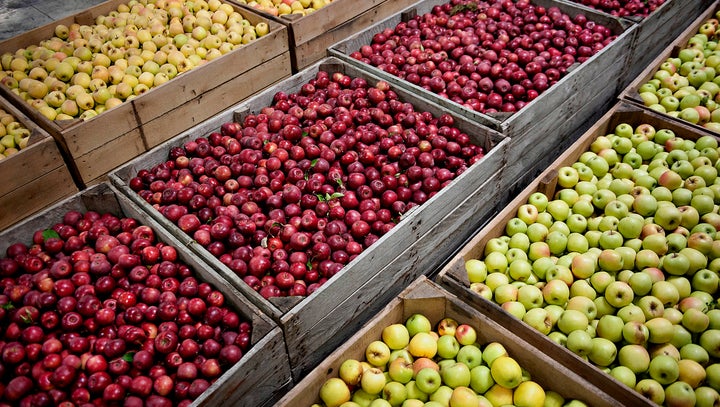
When you pick out an apple at the grocery store, you may not think much about where it came from. But the truth is that some apples take a fascinatingly long journey to get to you.
If you’re eating an American-grown apple at this time of year, chances are it’s been in storage for about five months now. Eat one in July, and it could’ve been stored for nearly a year.
Apples can last for months in specialized storage. If you think they’re picked and delivered straight to you year-round, then you’re mistaken.
“Apples are harvested once a year in the U.S.,” says Alisha Albinder, a fourth-generation fruit grower and distributor at New York’s Hudson River Fruit Distributors. “If you’re eating a New York apple not in the fall, then it’s safe to say that it’s been in storage.”
Here’s how the process goes down.

There are two types of apple storage.
There are two types of storage: regular refrigeration and controlled atmosphere. Apples ― which are harvested between August and November, depending on variety ― usually enter refrigeration if their growers intend to sell them by December, Albinder told HuffPost. These giant warehouses are kept at 34 to 38 degrees Fahrenheit, preserving sweetness and crunch until it’s time to ship them to a grocery store.
Apples that will be sold later in the year head to controlled atmosphere storage, or CA. In this giant warehouse, temperature is lowered and oxygen levels are reduced to almost nothing. Without oxygen, the apples can’t “breathe” or ripen, and they’re essentially frozen in time. Growers often call this stage “putting the apples to sleep.”
They can stay there for up to a year.
Apples stay in CA from harvest time, which varies based on variety, until selling time. For example, Gala is usually harvested in early September. So if you’re eating one in March, it’s been in CA for about five months.
Albinder says apples can last more than a year in CA, but by then new crops have usually been harvested, so there’s no point. When packers are ready to sell the apples, they un-seal the CA warehouse, let the oxygen levels return to normal and start selling.
By all counts, the apples should taste exactly the same.
“If it’s handled and stored properly, then it should taste the same as when it went in,” Albinder said.
You may wonder what this does to an apple’s nutritional content.
Surprisingly, not much. Apples may lose a bit of their acid in storage, but it’s not something consumers should worry about, says James Mattheis, a researcher with the United States Department of Agriculture.
Storage “doesn’t do very much to vitamin or mineral content,” he said. “Some compounds may be reduced a bit, but it doesn’t change things such that apples would no longer be nutritious.”
Rao Cao, a researcher at Agri-Food Canada, has studied how storage affects apple antioxidant levels. He too says the changes are nothing to worry about.
“CA storage up to eight months will not significantly alter the overall antioxidant potential,” he told HuffPost. Phew.
But the journey is a wonder enough.
While there’s nothing to worry about in terms of taste or nutrition, Albinder says she does wish people would start noticing where their apples were grown when choosing which ones to buy. The U.S. imports apples from countries like New Zealand, Argentina and Chile, whose apple seasons are later than ours. But of course, local farmers would prefer if you checked the sticker and chose theirs.
“I’d ask people to understand the value of having local fruit available,” she said. “There’s so much hard work and effort put into getting these products to you.”
And we’re very thankful for that.
